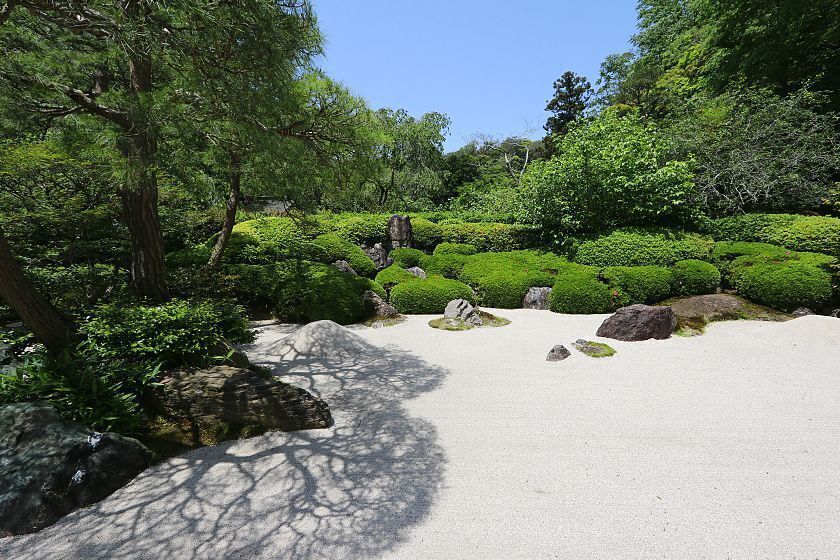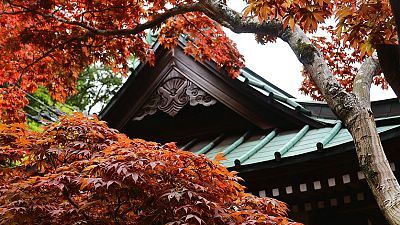Kamakura Rediscovered - Kita-Kamakura

Located just one stop north of Kamakura Station, Kita-Kamakura is a quiet, leafy area best known for its many historic temples, wooded surroundings and traditional houses, creating an atmosphere not unlike parts of Kyoto. Back in town for the third in my series exploring Kamakura one neighborhood at a time, I am greeted again by perfect weather, lush, almost jungle-like greenery and pavements dappled in sunlight and the shadows of leaves.

Making my way out of the little station's east exit, I immediately make a right turn across the tracks, passing by the Byakurochi or White Heron Pond that marks the entrance to the nearby Engakuji Temple.



Just across from the station, my first stop of the day is Tokeiji, a temple of the Rinzai Zen school dating to 1285. After the death of Hojo Tokimune, who ruled Japan as regent to the shogun, his wife took holy orders and founded the temple as a nunnery.
Over time, the site became known as a refuge for women escaping abusive marriages - in a time when divorce could normally be initiated only by men, a rare get-out clause existed for women who took sanctuary in the temple for a period of two years.
At least two-thousand women are known to have made use of this loophole during the Edo Period, and the practice continued until the 1870s when legal reforms by the Meiji government finally brought women some measure of independence.



Passing under a thatched gate, I find myself in a tranquil space with a few simple buildings shaded by thick undergrowth. The precinct is known for its wildflowers in summer, but for now there are only a few patches of color mixed into the thick tangle of grass.



To the rear of the temple, the path leads into a peaceful cemetary surrounded by tall trees. Interred within are a number of famous names, including the noted Buddhist scholar Suzuki Daisetz.

Immediately to my right as I make my way out of the temple is the Kita-Kamakura branch of Verve Coffee, an artisanal coffee chain with roots in California. Although not native to Japan, the brand has proven a hit with local coffee obsessives for its sleek, minimalist design and exacting third-wave philosophy.
The Kita-Kamakura branch doubles as the roastery supplying all four of the company's locations in Japan, so the coffee here is as fresh as it gets. Although usually the milk-and-sugar type, I decide to get into the spirit of things by ordering a single origin pourover, which arrives black, in a glass flask complete with tasting notes.



After what turns out to be an outstanding cup of coffee, I make my way back across the tracks and continue for a few minutes along a shaded street beside a little stream. On the way, I pass by the Yoh Shomei Museum - a distinctive western-style building housing a collection of paintings by a celebrated author of picture books.



I soon arrive at the entrance to Meigetsuin, another beautiful little temple of the Rinzai Zen school. Founded in 1162, it is the last remaining subtemple of a much larger complex that closed during the Meiji Period. Although its name translates as Temple of the Bright Moon, it is better known as the hydrangea temple for the thousands of flowers that come to life every year in June.
Inside the precinct, I take a left turn past an attractive teahouse. In a quiet spot under a thick canopy of leaves is the resting place of Hojo Tokiyori, the fifth Hojo regent of the Kamakura Government, beside a small pavilion dedicated to his spirit.


An uphill path towards the center of the precinct leads through one of the temple's signature views - an old wooden gate framed by tall hydrangea bushes.
Beyond the gate, across from a small garden of pristine raked gravel is the temple's hondo or main building. Through a distinctive circular window, my gaze is drawn straight through to an inner garden on the far side where colorful irises also bloom in June.


A few steps to the east, behind the founder's hall with its lovely thatched roof and just visible under thick green foliage is a yagura or cave tomb - an unusual form of burial found in just a few places in Japan. The largest of its kind in the Kamakura area, this one is thought to belong to Uesugi Norikata, a distinguished military commander of the Muromachi Period.


By now it's almost lunchtime, so I retrace my steps back towards the station. Crossing over to the other side of the tracks, I pass an antique shop and some little cafes before arriving at Takeru Quindici, an Italian restaurant located in a renovated former teahouse just a few steps from Tokeiji Temple.
Kamakura is well-known for its vegetables, and while the cuisine here is distinctly Italian, the emphasis on fresh, locally-grown ingredients and cosy, traditional interior combine to give it a strong sense of place.


My lunch here is an absolute delight in four courses - starting with an appetizer of light bites with a delicious, crunchy salad, followed by a plate of tagliatelle with shrimp in a creamy tomato sauce, slices of Sagami pork with roast vegetables and finally a gorgeous panna cotta dessert drizzled with caramel.


Feeling full and very satisfied, I make my way southwest to my final stop of the day at Kenchoji, a large temple complex of great cultural significance founded by Hojo Tokiyori in 1253.
An advanced student of Zen Buddhism himself, Tokiyori appointed his own mentor, the Chinese monk Rankei Doryu, as its first abbot. Under his leadership the temple quickly grew into an important training center, with over a thousand students and 49 subtemples. As the foremost of Kamakura's five great Zen Temples, Kenchoji functioned almost as an extension of the government, its priests working as translators, diplomats and civil servants.

Today, the complex is somewhat reduced but still forms a complete Zen Temple complex in the classical style, called shichido garan, and remains an important study center for priests in training.



From a veranda behind the Hojo, the main building that once served as the abbot's residence, I take a moment to enjoy a beautiful landscape garden designed by the famous Zen master Muso Soseki. Created from just a handful of different elements, the garden "borrows" the surrounding hills, while a large central pond takes the form of the Chinese character "kokoro", meaning heart or mind.

Behind the temple's larger buildings, I follow a path up a wooded hillside where winged, stern-faced tengu statues guard the tutelary shrine of Hansobo.



To the right of the shrine, the path continues uphill past a small building that is Kenchoji's inner sanctuary, to a shaded pass and the beginning of the Tenen hiking trail.

Visitors taking this path will arrive in about an hour at Zuisenji Temple (the trail is still partially closed due to a typhoon in 2019) - but for now I'm content to end my day here gazing out over the ciy towards the Sagami Bay.






